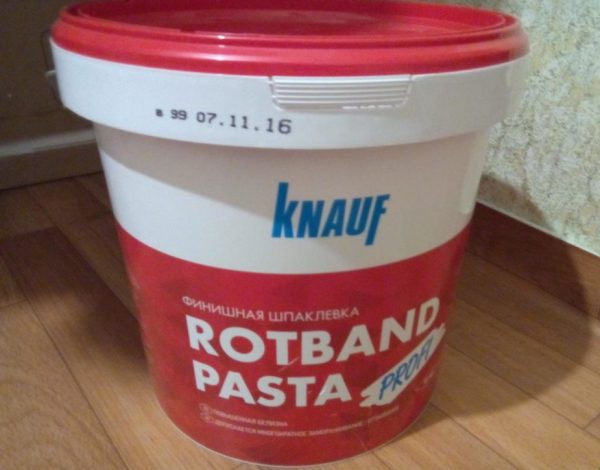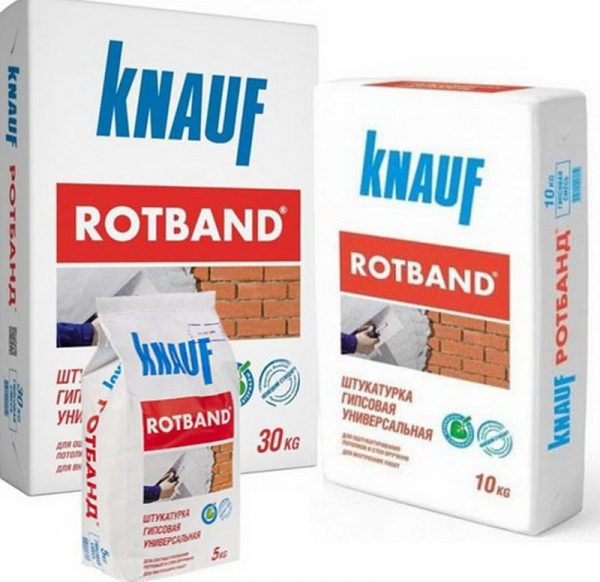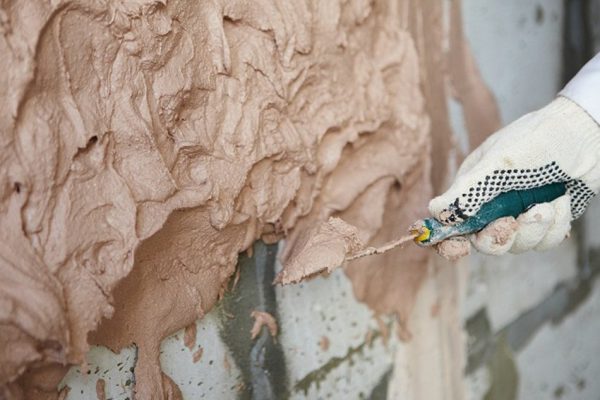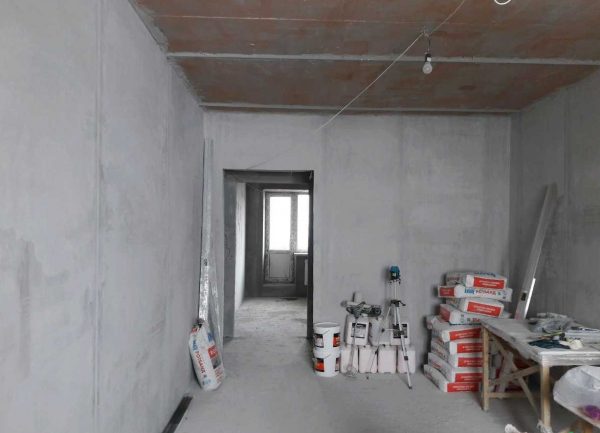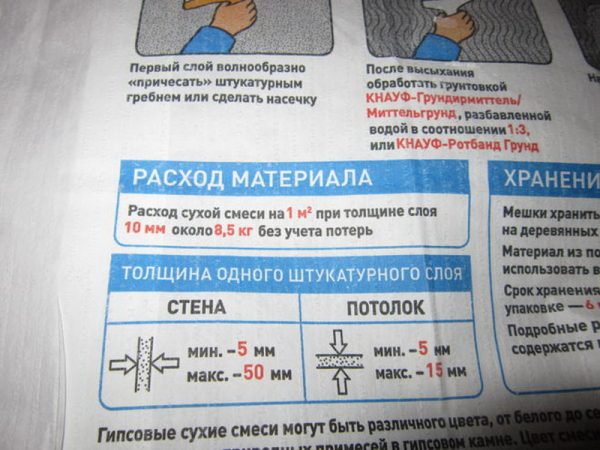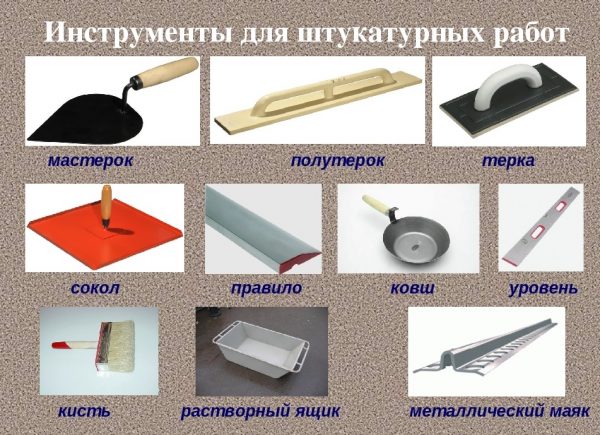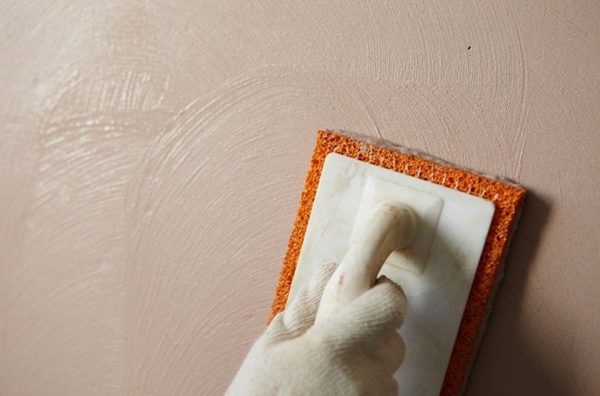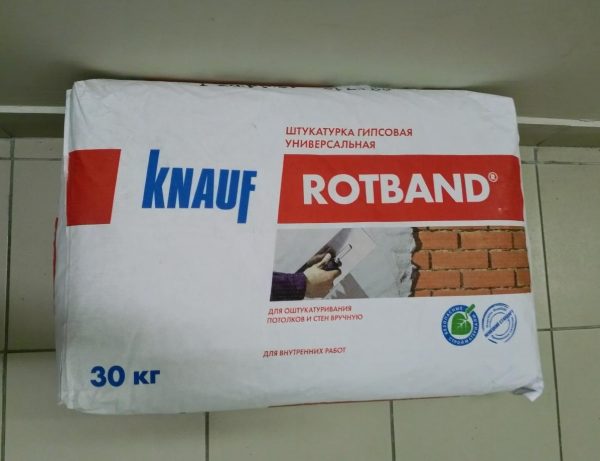Rothband plaster is well known to all builders and finishers. This material is one of the most durable, high-quality and in demand on the market, has a wide range of applications and meets the highest German standards by which it is manufactured.
- Stucco Features
- Specifications
- Release form
- Terms and conditions of storage
- Composition
- Color
- Fraction size
- Layer thickness
- Drying time
- Strength
- Plastic
- Adhesion and density
- Water holding capacity
- Frost resistance, moisture resistance, vapor permeability
- Thermal conductivity
- Resistance to various factors
- Consumption
- Scope of application of plaster
- How to work with plaster
- Preparatory stage
- Solution mixing
- Application of the composition
- Pruning
- Stucco grout
- Stucco gloss
- Decoration
- Advantages and disadvantages of plaster
- Comparison with other plasters
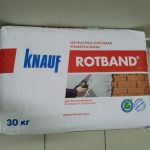
Stucco Features
Knauf Rotband plaster is a dry gypsum polyfunctional plaster mix "originally" from Germany, which for several decades has rightfully been the market leader in its segment. Translated from German, “rotband” is a “red ribbon”. This concept was proposed for commercialization by the founder of the company Karl Knauf for marketing purposes in order to distinguish between different product lines. The Rothband line also includes thin layer putty and decorative materials Rothband Profi (paste) and Rothband Finish (dry mix).
Gypsum plaster "Rotband" is used for interior work. It is ideally suited for decorating walls and ceilings, for their leveling and preparation for painting, gluing with wallpaper, tile and other finishing materials. The difference between Rothband and standard gypsum mixtures, which are often prepared directly at the construction site, is the presence of the special Alenal retarder. This additive slows down the setting process of gypsum, which is known to solidify very quickly. Due to this composition, the solution can be started in larger quantities and used for a longer time.
Gypsum plaster of this brand has other features that are its advantages:
- Universality. The material is suitable for many purposes - they can produce roughing, finishing and even decorating surfaces. "Rotband" will repair cracks and chips, eliminate small and large defects, increase adhesion between the decorative finish and the wall. Even in the absence of a primer, plaster will fulfill its task.
- High quality. Plaster is appreciated by the masters, as it invariably has efficiency, a perfectly even texture, no impurities, excellent adhesion to most building materials (gypsum concrete, concrete, OSB, cement, etc.).
- Adaptability for different situations. "Rotband" can be used in various climatic conditions. The plaster is suitable for rooms with low and moderate humidity, but with additional protection, it will be suitable for rooms with high humidity. Rothband is also suitable for both professional and private use.
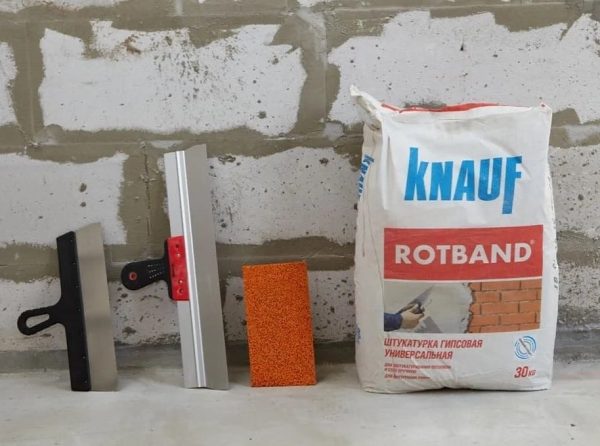
Specifications
The main technical parameters of the material determine its properties, quality, and application on different surfaces. Typically, finishers are interested in such characteristics as composition, shade of the mixture, possible layer thickness, drying time and a number of other indicators.
Release form
Rothband plaster is packaged in paper and plastic bags of different capacities. Most often on sale you can find packages of 5 kg and 30 kg, although there are other packaging (10 kg, 25 kg). As for the “Rotband” finish in pasty form, it should be looked for in plastic buckets of 5-25 kg each. To distinguish the original plaster from the fake, you need to pay attention to such signs:
- marking the date and time of production with an accuracy of seconds;
- the presence of the round stamp "German standard. Proven Quality ";
- the presence of special paper stamping strips on the top layer of the package.
Terms and conditions of storage
The shelf life of the plaster in a bag with preserved integrity is 6 months. The material should be stored in a dry ventilated area away from heat sources, direct sunlight, with the exception of increasing humidity throughout the warranty period. It is best to keep the material on wooden pallets. The temperature for safe storage of the mixture is + 5 ... + 25 degrees.
Composition
The exact composition of the plaster is kept secret by the manufacturer. It is known that it contains a finely divided gypsum mixture with the addition of chemical components that prevent early solidification. Also, the plaster composition includes components of mineral origin to increase elasticity, strength, minimize shrinkage and cracking. In order to improve adhesion and fluidity, the material is equipped with polymer additives (latex, resins, etc.).
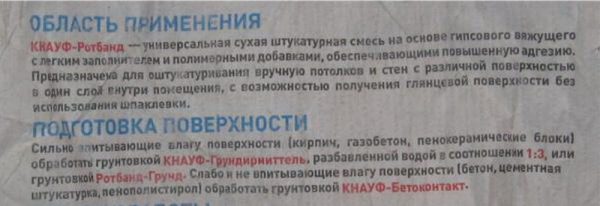
Color
The hue of the mixture must be selected based on the needs of the user. For finishing work, in most cases, the white material that is most often found in the store is ideal. White stucco mix is produced by the company's plants located in Germany, the Astrakhan region and the Krasnodar Territory.
Also, the "Rotband" is produced in a gray version, while its color is due to the characteristics of the mineral components, and not introduced pigments. Gray plaster - products of the plant in the city of Krasnogorsk. Plaster mixes with a pink tint are made in Chelyabinsk and Kolpino, since the gypsum mined in this area has this color. The tone of the plaster does not affect the quality of the finished coating, so it is not indicated on the package. If the shade of the mixture is really important, you can determine it by the manufacturer.
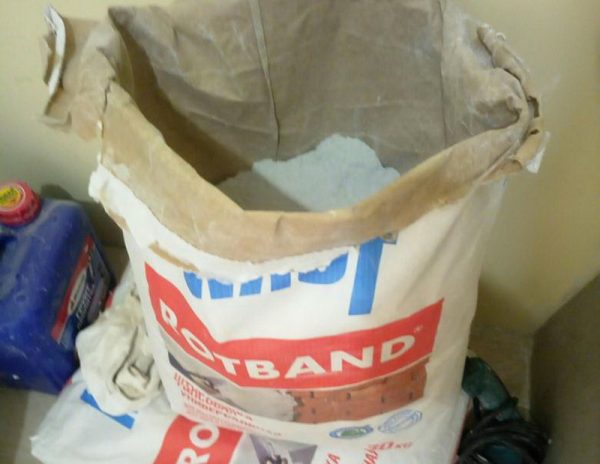
Fraction size
The granularity of gypsum plays an important role in the attractiveness and effectiveness of the use of plaster. All Rothband building mixes have a fine-grained texture, and yet the size of the fraction in them can be different. The maximum size of gypsum particles allowed by the manufacturer is 1.2 mm. The smallest fraction mineral (about 0.5 mm) is mined at the Chelyabinsk and Krasnogorsk deposits, and in Kolpino the grain size is about 1 mm.
The finer the fraction of the plaster, the better the finished mixture is applied, the smoother it is. Nevertheless, the finest dispersed plasters are mainly used to create a perfectly smooth surface for painting or paper wallpaper. To perform an independent decorative finish, it is worth choosing a coarse-grained coating, as well as for gluing walls with tiles.
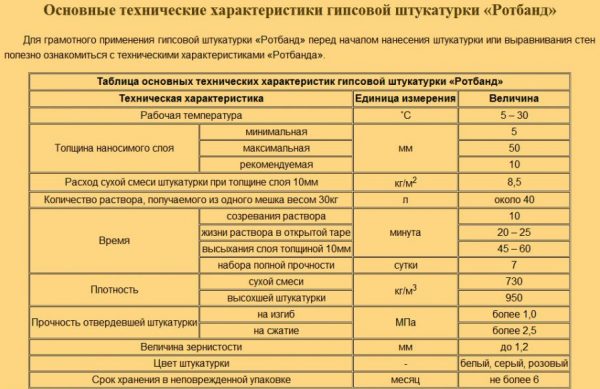
Layer thickness
The indicators of the minimum and maximum possible thickness of the plaster layer vary depending on the type of base. For example, when decorating walls, Knauf recommends applying a layer within 5-50 mm, and for ceilings - from 5 mm to 15 mm, no more. The layer in the range of 10-15 mm is considered optimal in quality and consumption, but this is possible only in the absence of serious deviations of the wall plane. If you need to make a thick layer of plaster (more than 50 mm), you will have to work according to this scheme:
- application of the Rotband construction mix with a thickness of up to 50 mm;
- complete drying of the finish;
- priming the surface by 2 times;
- applying a second layer of plaster with a thickness of 15-50 mm.
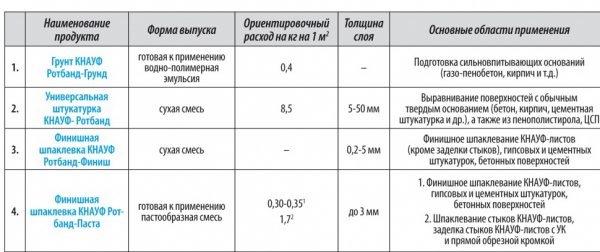
Drying time
The technical characteristics of the Rotband plaster indicated on the package necessarily include the setting and drying times of the mortar. Here are the main parameters of the solidification of the mortar:
- ripening time after combining the dry powder with water - 5-10 minutes;
- preservation of liquid consistency in a container without a lid - 30 minutes;
- drying of the plaster after application to the walls - 45-60 minutes (depends on the thickness of the layer, temperature and humidity in the room);
- complete drying of the coating before finishing work - 7 days.

Strength
The compressive strength or resistance of the plaster to pressure without damaging the integrity of the layer is 2.5 MPa. The strength of the "Rotband" bending is equal to 1 MPa. At home, it is impossible to measure these indicators, but in reality they fully correspond to the numbers indicated on the package.
Plastic
Rothband plaster perfectly fits walls and ceilings, is easily leveled, does not stick to tools, as it is highly flexible. It evenly fills chips, cavities, cracks and voids, easily penetrates the smallest defects. The plasticity of the plaster is due to the use of high-quality mineral raw materials, as well as the presence of synthetic modifiers.
to contents ↑Adhesion and density
The material boasts an excellent level of adhesion with various building foundations - brick, concrete, cement plasters, wood, drywall. After reliable adhesion of the plaster with the base, no cracks occur, in the future there is no shrinkage of the layer. If necessary, "Rotband" can be used to finish porous substrates, but only after preliminary priming. The density of the material in liquid and solidified form is 730 kg / cu. m and 950 kg / cubic m respectively.
to contents ↑Water holding capacity
Plaster has the ability to absorb excess water at high humidity and give it to porous substrates. Therefore, in order to avoid uneven drying and lower quality finishes should be pre-treated surfaces that can greatly absorb moisture.
Frost resistance, moisture resistance, vapor permeability
The plaster is able to withstand up to 75 cycles of freezing and thawing without loss of basic technical properties. It also has excellent vapor permeability and does not violate the natural indoor climate. The material can deteriorate under the influence of high humidity, although after special treatment it is even suitable for decorating a bathroom, toilet, kitchen.
to contents ↑Thermal conductivity
The thermal conductivity index of the plaster is 0.25 W / m, which makes it possible to use this material to additionally insulate the walls and maintain the optimum temperature in the house.
Resistance to various factors
The material is quite resistant to low temperatures, does not support open burning, does not deteriorate from temperature extremes. Nevertheless, during application, the temperature interval should be observed within + 5 ... + 30 degrees.
Consumption
The consumption of plaster per 1 m2, according to the manufacturer, is 8.5 kg. This figure is true when the thickness of the plaster layer is about 1 cm. Also, the instruction for use states that the solution yield from 100 kg of the dry mixture is 120 liters. When buying plaster, you should always take into account a small margin (5-15%).In practice, the processing of problem areas takes more finishing materials than the finishing of fairly even bases.
to contents ↑Scope of application of plaster
Plaster can be used to align walls and ceilings indoors. It allows you to smooth out defects between the plates, joints of the horizontal and vertical plane, eliminate cracks and cracks, chips and troughs. Thanks to the plaster, you can prepare any surface for subsequent decorative finishes.
Using the "Rotband" you can solve the following tasks:
- close up strobes for various purposes;
- smooth the joints between the sheets of gypsum plaster using a reinforcing tape;
- make slopes of window blocks (subject to isolation from moisture);
- increase sound and heat insulation of housing;
- to process thin brickwork and partitions during redevelopment.
Also, the plaster of this brand is suitable for creating smooth and textured decorative coatings, for the manufacture of imitation stucco moldings, various volumetric elements on the walls and ceiling. The building mixture can be tinted with dry pigments and perform various drawings and relief images.
to contents ↑How to work with plaster
The degree of complexity of the finishing work depends on the evenness of the initial surface, the requirements for the quality of the finished coating, and the type of finish. For the application of plaster, and especially for the preparation of walls, it is necessary to stock up on personal protective equipment - gloves, a respirator, goggles, and also tight clothing. As for the tools, to work with the "Rotband" prepare:
- building level;
- trowel and spatulas;
- the rule is ordinary and trapezoidal;
- Master OK;
- grater;
- brush or roller;
- construction mixer;
- breeding tank;
- ladder.
to contents ↑The plaster of this brand can be applied both mechanized way, and with the help of hand buckets, and conventional building equipment - the choice is the master. With significant irregularities of the walls, plastering along the lighthouses is used.
Preparatory stage
Initially, the walls, as well as the room itself, must be carefully prepared for plastering. For this, construction debris is taken out of the room, all coatings are removed from dust, and surfaces are protected from possible plaster ingress (glued with cellophane, construction tape). In new buildings, they immediately start plastering, and in the rooms where the repair has already been completed, the old finish is removed:
- clean off the falling plaster;
- wipe or polish the paint;
- wash off the lime;
- moisten with water and peel off the wallpaper.
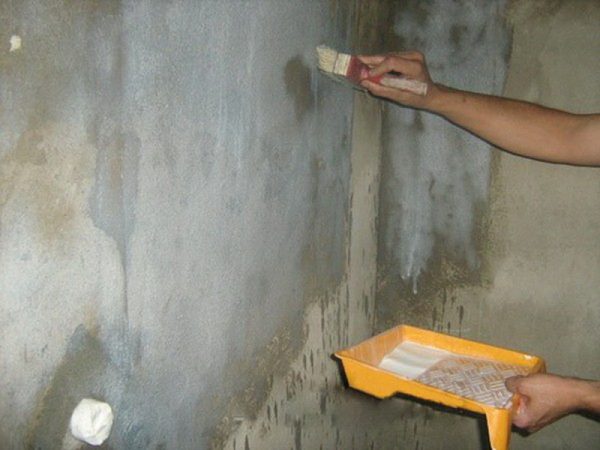
In addition, grind all the convexities of the base and large irregularities, for which use sandpaper or a grinding machine. Metal elements are treated with an anticorrosive composition. Next, they are primed with Knauf or other compatible formulations. The primer is applied in 2 layers with a break of 24 hours. If required, set gypsum beacons with a gap of 40 cm, aligning them in one plane with a level.
to contents ↑Solution mixing
For high-quality application of plaster it must be properly diluted. The dry powder from the bag is mixed with water in the proportion specified by the manufacturer. To do this, 18 liters of water are poured into a basin or other convenient container, after which the contents of a 30-kg packet are poured in portions, regularly mixing with a mixer. Mixing must be carried out until even the smallest lumps disappear from the mass, and it itself begins to resemble thick sour cream. After 5-10 minutes of "maturing" of the plaster under the lid or film, mix it again, after which it will be ready for application.
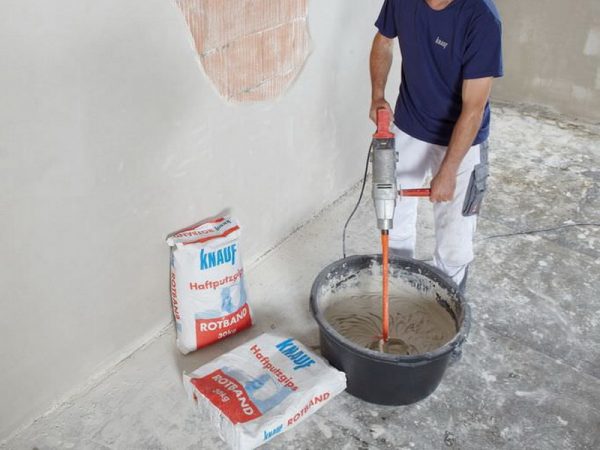
Professionals advise immediately pour a little less liquid than indicated by the manufacturer. To dilute too thick a mixture is quite easy, while adding dry powder to an excessively liquid mass is problematic. If the plaster applied to the walls has the wrong consistency, such troubles are possible:
- cracking of the layer;
- the appearance of tubercles from unmixed lumps;
- plaster detachment;
- swelling of the layer.
Application of the composition
The plaster is applied to the walls by throwing with a spatula or trowel and then smoothing the rule using wave-like movements. With significant irregularities, classic technology is used - applying plaster in 3 layers:
- Spray A solution is put between the beacons with a trowel, evened out with a rule until a layer of 5-6 mm is obtained, and allowed to dry.
- Priming. A second layer of the required thickness is applied with a spatula, rubbed with a trowel. For relatively flat walls, this step can be completed. For old, crumbling coatings, it is better to carry out additional reinforcement with a special mesh directly on the crude second layer, and then perform the third.
- Hiding. It is applied with a spatula, rubbed with a construction grater. This layer is intended for the final smoothing of base defects.
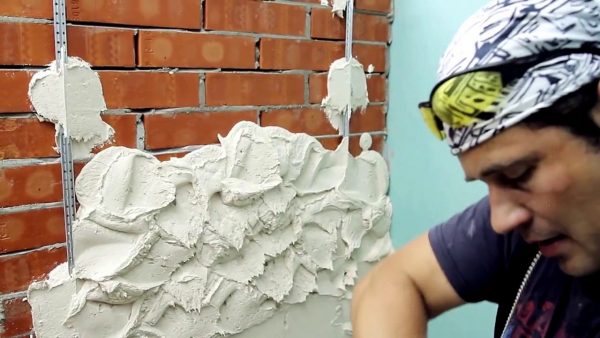
to contents ↑Alignment is made on the ceiling with a special tool - the "falcon", moving it towards you. A reference point for alignment in this case is a cord stretched between metal beacons.
Pruning
This step is carried out after applying the single or last layer of plaster approximately 40 minutes after completion of the work. After the specified time, gypsum plaster has already set, but has not yet completely frozen. For trimming, it is best to use a metal rule of a trapezoidal shape with sharp edges. With its help, all irregularities and bumps that still remain on the surface of the wall after mashing are easily cut off. If the work at the previous stages was performed very efficiently, you can not trim.
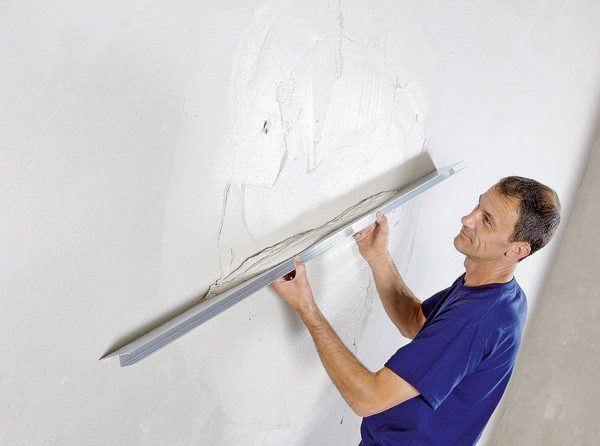
Stucco grout
When the walls are being finished for painting, grouting is done on a set layer of gypsum using a building grater. The tool is pressed against the wall, wiped the surface in a circular motion, so that it becomes perfectly smooth.
to contents ↑Stucco gloss
Usually this technique is also used before painting the walls. It consists in the following: after 4 hours after grouting, the plaster is slightly sprayed with water and again treated with a metal trowel.
Decoration
The finished plaster layer can be painted with latex or acrylic paint. The coating can be monophonic or multi-colored, with patterns made on a stencil or with other interesting decor. It is also possible to form a relief on still non-solidified material. For this purpose, plastering is carried out with special textured rollers, stamps or draw the desired ornament manually, using a trowel or other convenient tool. Most often use this decor:
- imitation of stone or brick;
- strips;
- Christmas trees
- geometric figures;
- floristic motifs.
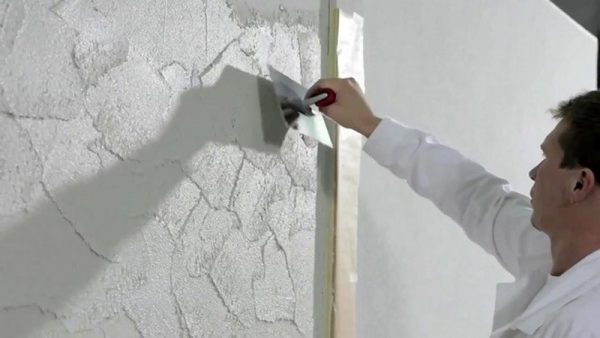
to contents ↑To obtain a “rain” structure, brushes with a hard pile or special painting graters can be used. From above, such a coating is also painted or varnished. An original solution is to disperse the paint onto the wall with a damp brush or an ordinary broom.
Advantages and disadvantages of plaster
Gypsum-based Rotband plaster has a number of undeniable advantages:
- ecological cleanliness and complete safety for humans;
- plasticity, easy distribution on the working surface;
- smooth, pleasant to the touch texture, suitability for all types of finishes;
- participation in the formation of a favorable microclimate in the house, the ability to quickly absorb and absorb moisture;
- the exception of the settlement of fungus and mold, hygiene;
- excellent sound and heat insulating characteristics;
- high adhesion to building materials;
- excellent leveling and decorative properties;
- low risk of shrinkage and cracking;
- moderate consumption and profitability;
- quick drying, the ability to quickly proceed to the finish;
- small mass of the plaster layer.
Disadvantages of the "Rotband" are also available. Despite the economical consumption, the price of the plaster itself is quite high, especially compared to domestic brands. The product is resistant to cracking, but under a number of conditions it can still shrink. This happens due to improper establishment of the solution, in violation of the technology of applying the mixture. In addition, gypsum plasters are poorly suited for outdoor work and unheated rooms and can not be used in these cases without additional protection.
to contents ↑Comparison with other plasters
Among the Knauf brand products there are other plasters based on mineral and polymer substances that have leveling properties. They have some features in the destination:
- Knauf Eisberg - white plaster for light finish coatings;
- Knauf Goldband - a solution for leveling walls with gross defects (has less adhesion with smooth bases);
- Knauf HP Start - a starting mixture for creating a plaster layer with a thickness of 10-30 mm.
In fact, all of these materials can be used interchangeably; there are no significant differences between them. "Rotband", as well as the three specified plasters, are often applied manually, although mechanized use is possible. If you have to finish on large areas, it is better to buy other building mixtures, for example, Knauf MP 75 or Knauf MP 75 Ultra. They are ideal for use in professional plastering stations and other units. The range of plasters of the company is large enough to easily select the most suitable for a particular situation and perform high-quality finishing work.

